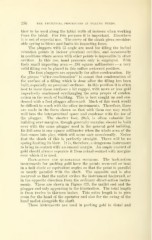Page 536 - My FlipBook
P. 536
256 THE TECHNICAl, PROCEDURES IN FILLING TEETH.
blow to be used along the labial walls of incisors when working
from the labial. For this purpose it is important. Elsewhere
it is not of especial use. The curve of the shank gives consider-
able spring to blows and limits its impacting force.
The pluggers with 23 angle are used for filling the incisal
retention points in incisor proximal cavities, and occasionally
in iDositions where access with other points is impossible in other
cavities. In this use, hand pressure only is employed. With
their small impacting area — .196 square millimeters — a very
solid filling can be placed in this rather awkward position.
The foot pluggers are especially for after-condensation. By
the phrase "after-condensation" is meant that condensation of
the surface of a filling which is done after the filling has been
built, especially on proximal surfaces. In this position it is often
best to leave these surfaces a bit ragged, with more or less gold
imperfectly condensed overhanging the area proper of conden-
sation in the work of building. This is best caught up and con-
densed with a foot plugger afterward. Much of this work would
be difficult to reach with the other instruments. Therefore, these
are made in the form shown so that with them one may reach
well into the interi^roximal space and condense with the toe of
the plugger. The shorter foot, 20x5, is often valuable for
building over margins, though generally margins should l)e built
over with the same plugger used in the general gold building.
Its full area is one square millimeter when the whole area of the
foot comes into play, which will occur only occasionally. Notice
that the shank of this is perfectly straight. There will be no
spring limiting its blow. It is, therefore, a dangerous instrument
to bring in contact with an enamel margin. An ample amount of
gold should always separate it from actual contact with margins
over which it is used.
Back-action and quadrangle pluggers. The back-action
instruments for packing gold have the points recurved or bent
in a half circle or equivalent angles so that the point is parallel
or nearly parallel with the shaft. The opposite end is also
recurved so that the mallet strikes the instrument backward, or
in the opposite direction from the ordinary direct-action instru-
ments. These are shown in Figure 325, the mallet end and the
plugger end only appearing in the illustration. The total length
is from twelve to thirteen inches. This extra length is to give
room for the hand of the operator and also for the swing of the
hand mallet alongside the shaft.
These instruments are used in packing gold in distal and


